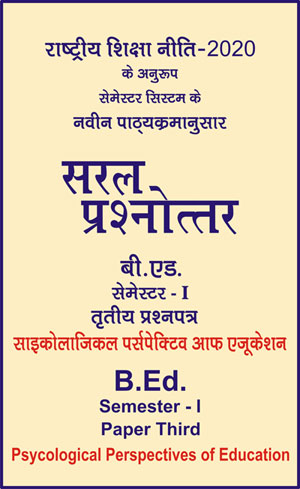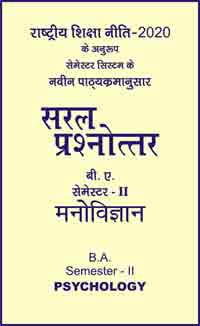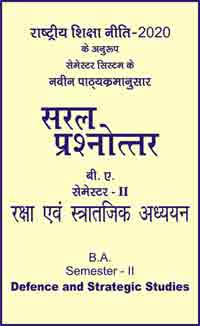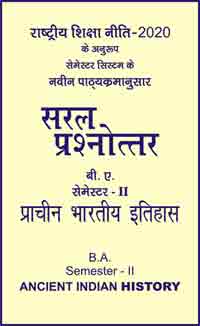|
बी एड - एम एड >> बी.एड. सेमेस्टर-1 प्रश्नपत्र-III - साइकोलाजिकल पर्सपेक्टिव आफ एजूकेशन बी.एड. सेमेस्टर-1 प्रश्नपत्र-III - साइकोलाजिकल पर्सपेक्टिव आफ एजूकेशनसरल प्रश्नोत्तर समूह
|
5 पाठक हैं |
|||||||
बी.एड. सेमेस्टर-1 प्रश्नपत्र-III - साइकोलाजिकल पर्सपेक्टिव आफ एजूकेशन (अंग्रेजी भाषा में)
Question- Write a detailed note on Piaget’s theory of development.
Or
Describe the Piaget’s ‘theory of Cognitive development’ or ‘development state theory’.
Answer-
Piaget’s theory of Cognitive Development
Piaget’s theory of cognitive development is a comprehensive theory about the nature and development of human intelligence. It was originated by the Swiss development psychologist Jean Piaget (1896-1980). The theory deals with the nature of knowledge itself and how humans gradually come to acquire, construct, and use it. Piaget’s theory is mainly known as a development stage theory.
In 1919, while working at the Alfred Binet Laboratory School in Paris, Piaget “was intrigued by the fact that children of different ages made different kinds of mistakes while solving problems”.
Piaget came up with four different cognitive development stages,
According to Piaget, cognitive development was a progressive reorganization of mental processes resulting from biological maturation and environmental experience. He believed that children construct an understanding of the world around them, experience discrepancies between what they already know and what they discover in their environment, then adjust their ideas accordingly. Moreover, Piaget claimed that cognitive development is at the center of the human organism, and language is contingent on knowledge and understanding acquired through cognitive development.
Nature of Intelligence : Operative and Figurative
Piaget noted that reality is a dynamic system of continuous change. He argued that reality involves transformations and states. Transformations refer to all manners of changes that a thing or person can undergo.
He proposed that operative intelligence is responsible for the representation and manipulation of the dynamic or transformational aspects of reality, and that figurative intelligence is responsible for the representation of the static aspects of reality.
Operative intelligence is the active aspect of intelligence. It involves all actions, overt or covert, undertaken in order to follow, recover, or anticipate the transformations of the objects or persons of interest. Figurative intelligence is the more or less static aspect of intelligence, involving all means of representation used to retain in mind the states (i.e., successive forms, shapes or locations) that intervene between transformations.
To Piaget, assimilation meant integrating external elements into structures of lives or environments, or those we could have through experience. Assimilation is how humans perceive and adapt to new information. It is the process of fitting new information into pre-existing cognitive schemas.
Four Stages of Development - In his theory of cognitive development, Jean Piaget proposed that humans progress through four developmental stages.
(i) Sensorimotor Stage - The first of these, the sensorimotor stage “extends from birth to the acquisition of language”. In this stage, infants progressively construct knowledge and understanding of the world by coordinating experiences (such as vision and hearing) from physical interactions with objects (such as grasping, sucking, and stepping). Infants gain knowledge of the world from the physical actions they perform within it. They progress from reflexive, instinctual action at birth to the beginning of symbolic thought toward the end of the stage.
(ii) Preoperational Stage - He said that this stage starts towards the end of the second year. It starts when the child begins to learn to speak and lasts up until the age of seven. During the pre-operational stage of cognitive development, Piaget noted that children do not yet understand concrete logic and cannot mentally manipulate information. Children’s increase in playing and pretending takes place in this stage. However, the child still has trouble seeing things from different points of view. The children’s play is mainly categorized by symbolic play and manipulating symbols. Their observations of symbols exemplifies the idea of play with the absence of the actual objects involved.
Egocentrism occurs when a child is unable to distinguish between their own perspective and that of another person. Children tend to stick to their own viewpoint, rather than consider the view of others. Indeed, they are not even aware that such a concept as “different viewpoints” exists. Egocentrism can be seen in an experiment performed by Piaget and Swiss developmental psychologist Barbel Inhelder, known as the three mountain problem.
Similar to preoperational children’s egocentric thinking is their structuring of a cause and effect relationships. Piaget coined the term “precausal thinking” to describe the way in which preoperational children use their own existing ideas or views, like in egocentrism, to explain cause-and-effect relationships. Three main concepts of causality as displayed by children in the preoperational stage include: animism, artificialism and transductive reasoning.
At between about the ages of 4 and 7, children tend to become very curious and ask many questions, beginning the use of primitive reasoning. There is an emergence in the interest of reasoning and wanting to know why things are the way they are. Piaget called it the “intuitive substage” because children realize they have a vast amount of knowledge, but they are unaware of how they acquired it. Contraction, conservation irreversibility, class inclusion, and transitive inference are all characteristics of preoperative thought.
(iii) Concrete Operational Stage - The concrete operational stage is the third stage of Piaget’s theory of cognitive development. This stage, which follows the preoperational stage, occurs between the ages of 7 and 11 years and is characterized by the appropriate use of logic. During this stage, a child’s thought processes become more mature and “adult like”. They start solving problems in a more logical fashion. Abstract, hypothetical thinking is not yet developed in the child, and children can only solve problems that apply to concrete events or objects. At this stage, the children undergo a transition where the child learns rules such as conservation. Piaget determined that children are able to incorporate inductive reasoning. Inductive reasoning involves drawing inferences from observations in order to make a generalization. In contrast, children struggle with deductive reasoning, which involves using a generalized principle in order to try to predict the outcome of an event.
Commonly experience difficulties with figuring out logic in their heads. For example, a child will understand that “A is more than B” and “B is more than C”. However, when asked “is A more than C?”, the child might not be able to logically figure the question out mentally.
Two other important processes in the concrete operational stage are logic and the elimination of egocentrism.
Egocentrism is the inability to consider or understand a perspective other than one’s own. It is the phase where the thought and morality of the child is completely self-focused. During this stage, the child acquires the ability to view things from another individual’s perspective, even if they think that perspective is incorrect. For instance, show a child a comic in which Jane puts a doll under a box, leaves the room, and then Melissa moves the doll to a drawer, and Jane comes back. A child in the concrete operations stage will say that Jane will still think it’s under the box even though the child knows it is in the drawer. (See also False-belief task.)
In this stage the adolescent is able to understand love, logical proofs and values. During this stage the young person begins to entertain possibilities for the future and is fascinated with what they can be.
Adolescents also are changing cognitively by the way that they think about social matters. One thing that brings about a change is egocentrism. This happens by heightening self-consciousness and giving adolescents an idea of who they are through their personal uniqueness and invincibility. Adolescent egocentrism can be dissected into two types of social thinking: imaginary audience and personal fable.
Classification - As children’s experiences and vocabularies grow, they build schemata and are able to organize objects in many different ways. They also understand classification hierarchies and can arrange objects into a variety of classes and subclasses.
Identity - One feature of concrete operational thought is the understanding that objects have qualities that do not change even if the object is altered in some way. For instance, mass of an object does not change by rearranging it. A piece of chalk is still chalk even when the piece is broken in two.
Reversibility - The child learns that some things that have been changed can be returned to their original state. Water can be frozen and then thawed to become liquid again; however, eggs cannot be unscrambled. Children use reversibility a lot in mathematical problems such as: 2 + 3 = 5 and 5 - 3 = 2.
Conservation - Remember the example where children in the pre-operational stage think that a tall beaker filled with 8 ounces of water had more water than a short, wide bowl also filled with 8 ounces of water? This example shows the concept of conservation.
Decantation - Concrete operational children no longer focus on only one dimension of any object.
Children can start to consider the changes in other dimensions too.
Seriation - Managing items along a quantitative dimension, such as length or weight, in a methodical way is now demonstrated by the concrete operational child. For example, they can logically arrange a series of different-sized sticks in order by length.
(iv) Formal Operational Stage - The final stage is known as the formal operational stage. Intelligence is demonstrated through the logical use of symbols related to abstract concepts. This form of thought includes “assumptions that have no necessary relation to reality.” At this point, the person is capable of hypothetical and deductive reasoning. During this period, “hypothetic reasoning” becomes important during the formal operational stage. This type of thinking involves hypothetical “what-if” situations that are not always rooted in reality, i.e. counterfactual thinking. It is often required in science and mathematics.
Abstract thought emerges during the formal operational stage.
Metacognition, the capacity for “thinking about thinking” that allows adolescents and adults to reason about their thought processes and monitor them.
Problem-solving is demonstrated when children use trial-and-error to solve problems.
Children in primary school years mostly use inductive reasoning, but adolescents start to use deductive reasoning. Inductive reasoning is when children draw general conclusions from personal experiences and specific facts. Adolescents learn how to use deductive reasoning by applying logic to create specific conclusions from abstract concepts. This capability results from their capacity to think hypothetically.
The stages and causation - Piaget sees children’s conception of causation as a march from “primitive” conceptions of cause to those of a more scientific, rigorous, and mechanical nature. These primitive concepts are characterized as supernatural, with a decidedly non-natural or non-mechanical tone. Piaget has as his most basic assumption that babies are phenomenists.
|
|||||














